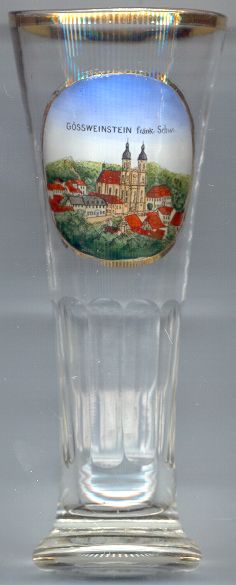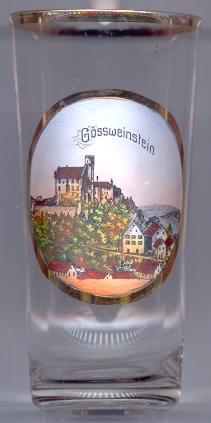

|
| DEUTSCHLAND | GERMANY |
| Bundesland: Freistaat Bayern | Bavaria |
| Regierungsbezirk: Oberfranken | |
| Landkreis: Forchheim |
 Gößweinstein is situated in one of Germany's most lovely landscapes, the 'Fränkische Schweiz'.
The first mention of the castle Goswinesteyn dates from 1076. Both the castle and the village must have existed already for some time
before that date. Due to the protection by the castle, the village grew and many craftsmen came to Gößweinstein especially during the 13th century.
The village received fortifications in the 15th century. Gößweinstein obtained the status of a market town in the mid-18th century.
Gößweinstein is situated in one of Germany's most lovely landscapes, the 'Fränkische Schweiz'.
The first mention of the castle Goswinesteyn dates from 1076. Both the castle and the village must have existed already for some time
before that date. Due to the protection by the castle, the village grew and many craftsmen came to Gößweinstein especially during the 13th century.
The village received fortifications in the 15th century. Gößweinstein obtained the status of a market town in the mid-18th century.
The monastery of Gößweinstein was founded as a Capuchin monastery in 1723 by Count Lothar Franz von Schönborn, Prince Bishop of Bamberg.
Since 1828 it is a Franciscan monastery. The  pilgrimage basilica Heiligste Dreifaltigkeit (Most Holy Trinity)
[left] was built in 1730–1739 by Prince Bishop Friedrich Karl Count of Schönborn. The church is one of the most important
Baroque churches of Franconia and is a masterpiece of the famous architect Balthasar Neumann. The magnificent high altar holds a wooden
sculpture of the Coronation of Our Lady by the Holy Trinity of around 1510 as object of veneration.
The church was granted the status of a Basilica minor in 1948.
Another well-known pilgrimage church designed by
B. Neumann is the basilica of Vierzehnheiligen.
pilgrimage basilica Heiligste Dreifaltigkeit (Most Holy Trinity)
[left] was built in 1730–1739 by Prince Bishop Friedrich Karl Count of Schönborn. The church is one of the most important
Baroque churches of Franconia and is a masterpiece of the famous architect Balthasar Neumann. The magnificent high altar holds a wooden
sculpture of the Coronation of Our Lady by the Holy Trinity of around 1510 as object of veneration.
The church was granted the status of a Basilica minor in 1948.
Another well-known pilgrimage church designed by
B. Neumann is the basilica of Vierzehnheiligen.

(see also list of other basilicae minores depicted on glasses of this collection)
 Gößweinstein castle [right] is situated high on a rock some 160 m above the valley of the
river Wiesent. The castle goes back to the 11th century and was first mentioned in 1076. For centuries it was in possession of the bishops of Bamberg.
Later it was in possession of the state of Bavaria. Today it is a private property. The castle was remodelled frequently throughout the centuries.
The round tower was not part of the medieval castle, but was built at the end of the 17th century. The romantic medieval appearance was finally
created in 1890.
Gößweinstein castle [right] is situated high on a rock some 160 m above the valley of the
river Wiesent. The castle goes back to the 11th century and was first mentioned in 1076. For centuries it was in possession of the bishops of Bamberg.
Later it was in possession of the state of Bavaria. Today it is a private property. The castle was remodelled frequently throughout the centuries.
The round tower was not part of the medieval castle, but was built at the end of the 17th century. The romantic medieval appearance was finally
created in 1890.
![[scale]](lineal.jpg)